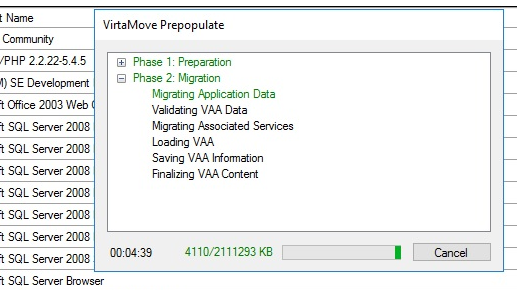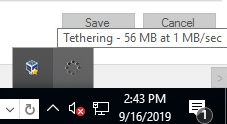Double-click the Administrative Console desktop shortcut icon on your desktop or click Start>VirtaMove>Administrative Console. Administrative Console opens.
Click Application>Create Empty VAA. In the VAA Name field, enter the full path and name of the container you want to create. Spaces in the pathname are not permitted. For example, C:\appliances\<container>, where <container> is the name of the container. Click OK.
Navigate to the Tether tab and check the Use Tether checkbox.
In the Source Name field, specify the IP address or name of the source machine you want to connect to. Specify only an Administrator account.
Alternatively, click the Query Network button to display a list of machines on your network, and then select a machine and click OK to populate the Source Name field. If a source machine has a VirtaMove Source Agent installed on it, the Remote Discovery window will display Yes in the Source Agent column. You can sort the list by selecting a column heading to sort by.
If you specified a source machine that has a Source Agent installed on it, the User Name field and the Password field are automatically filled in when you click away from the Source Name field. A green check mark and "Source Agent" are displayed to the right of the Source Name field. Go to step 7.
If you did not specify a source machine with a Source Agent, go to step 5.
In the User Name field, type the username of the local administrator account on the source machine you specified in the previous step. The default username is Administrator.
In the Password field, type the password of the local administrator account on the source machine.
Run an Audit of the source and destination machine by clicking the Run Audit button. If credentials fail or pre-requisites have not been met for tethering, an error message is displayed at the bottom of the Administrative Console window. To scroll through messages, click the Back or Forward button on the left or right of the message bar. You can view the Audit Report by going to the Appliance Logs tab to determine what the problem is.
Click the Find Applications button. VirtaMove retrieves all remote applications, services, and user/group account information and displays this information in the tabs in the bottom half of the Tether window.
In the Source Products tab, select the Microsoft SQL Server application packages. Also, select the packages for Visual Studio and Microsoft Office Web Components. When you click away from this tab, VirtaMove automatically selects all user/group accounts, services, and executables associated with the installed application and displays these in the Source Services and Source Accounts tabs.
Click the Source Services tab and review the source services that were automatically selected for the container. Make note of the main SQL Server service name, e.g., MSSQLSERVER or MSSQL$EXPRESS. Select any other services that may be related to your product if it is not already selected.
If you select a service and the service is "Started" on the remote machine, tethering will not succeed. Stop the service before tethering by right-clicking the service and then selecting Stop Source Service.
If you select a service and the service already exists on the underlying operating system, the Source Status column will display "CONFLICT" and a message will be displayed in the message bar at the bottom of the Administrative Console window. Resolve the conflict and then press F5 to refresh the list.
Click the Source Accounts tab and review users and group accounts that have been selected and select other user and accounts that you think are required for your product. For example, you may need to select the user account AnalysisServices. If you select user accounts that do not correspond to a service, these accounts will be imported to the operating system of the destination machine with the default password 1password! when you dock the container. VirtaMove recommends that you change the passwords of these accounts at the earliest opportunity. The password can be changed from the Credentials tab at the top of the Administrative Console. For more information about changing the default password to a different password if required, see Default Password.
Optionally, specify a https://virtamove.atlassian.net/wiki/spaces/VDOC/pages/311263613/Config-on-the-Fly?search_id=41984cea-9a25-4660-bf6d-f6cc963d3d07 (COTF) file.
Standard - By default VirtaMove loads the standard COTF file (
C:\appliances\<vaa name>\COTF\StandardCOTF.xml) and passes to the file the source name you specified in step 3.Custom - Select or specify a customized COTF file, for example:
MyCustomCOTF.xmlVirtaMovesupports paths that are relative to the container folder. That is, VirtaMove supports:".\COTF\StandardCOTF.xml"
or the absolute full path:"C:\appliance\ContainerName\COTF\MyCustomCOTF.xml"
You can also specify only the file name of the COTF file if the file is in the COTF folder. For example:"StandardCOTF.xml"
When you are ready, click the Pre-Populate button. If you have not yet activated your VirtaMove license key, you will now be prompted to do so. See https://virtamove.atlassian.net/wiki/spaces/VDOC/pages/311033861/Activating+Your+VirtaMove+License?search_id=ffc34620-456e-446f-ae4c-a7c98b381292 for information. Note that the pre-populate portion process may take some time. A window displays the status of the Pre-Populate process and the amount of data copied. If you hover over the data moved in green, you can see the estimated time remaining. You can cancel the process by clicking Cancel.

At the Migrating application data stage of pre-populate, the Tether Monitor icon in the system tray will spin until the end of the process. If you hover over the spinning icon, a tooltip will show the file size transferred and the rate of transfer.

Click the Close button in the VirtaMove Pre-Population window to close the window when the process is complete.
Once the pre-population has completed, dock the container by clicking on the Dock button. Once docked, the tether process will begin copying data across.
Once the container is docked, you can run the SQL rehosting scripts. Using a regular command shell, navigate to the VirtaMove/Extras folder. You will find the main script "StartSQLRehost.bat". Call it with arguments to the full path of the VAA, the SQL service name, and the SQL version. See examples below. You can also use the Admin console Launch option under the Tether Tab to perform the SQL rehosting.
c:\program files\virtamove\extras\SQLServer\StartSQLReshost.bat "C:\appliances\SQL200VAA" MSSQLSERVER 2000 |
or
c:\program files\virtamove\extras\SQLServer\StartSQLReshost.bat "C:\appliances\SQL2005VAA" MSSQLSERVER 2005 |
Note: If you are migrating Microsoft SQL Server 2008, SQL Server 2008 R2, SQL Server 2005, or SQL Server 2000 to Windows Server 2012 R2 or higher, Windows may display a compatibility prompt. Select Run the Program without getting help and proceed with rehosting; the rehosting script will execute successfully.
On the Services tab in the Administrative Console, right-click the services and select Start to start services.
In the Tether tab, click the Launch Application button.
Select the SQL applications you want to launch. Select SQL Server Management Studio to make sure that you can log in to your new server and that you can query the database tables.
Exercise the applications you selected as much as possible.
When you are satisfied that the main components of your applications have been migrated, do the following:
Close your applications.
Click the Source Services tab, and then right-click each service and select Stop.
Optionally, click Undock and then dissolve the container to the underlying OS by clicking the Dissolve button at the top of the Administrative Console window.
OR run undock and then Dissolve from the CLI:
virtadissolve Appliance /M:<SID_in_appliance>=<SID_in_host>,...][/M:?] [/F] |